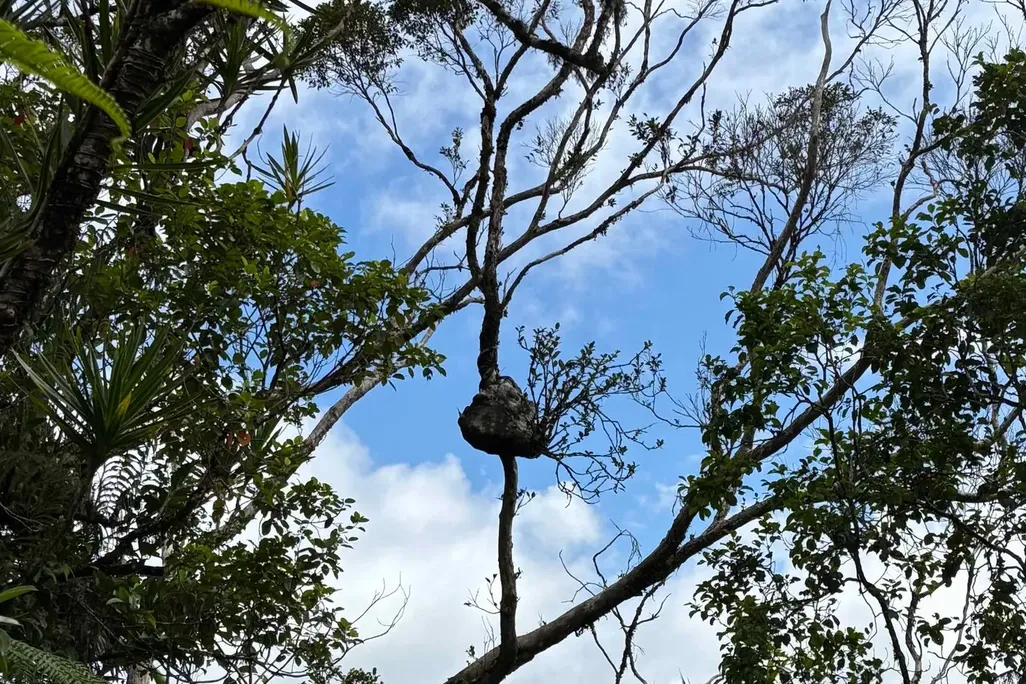Enemy Ant Colonies Are Peaceful Roommates in Apartment-Like Plants on Fiji. Scientists Discovered How This Delicate Coexistence Works
New research explores the surprising symbiotic relationship between tubers and different ant species at rainforest heights

High in the rainforest canopies that stretch across the South Pacific island of Fiji, an unlikely peace prevails thanks to a unique symbiotic relationship.
At its heart: a tuber with a unique internal structure that allows rival ant colonies to coexist with an “out of sight, out of mind” ethos, according to new research published last week in the journal Science.
Plants of the genus Squamellaria are epiphytes, which means their roots don’t attach to the ground. In need of stability, they grow instead nestled within the tall branches and trunks of other trees. The relationship is an example of commensalism: host trees offer Squamellaria a stable habitat and are themselves unaffected by these top-floor guests.
Once settled, Squamellaria get into the business of real estate. At the base of their stems, the plants grow a hollow structure called a domatium that eventually swells to roughly the size of a soccer ball. Its sound structure is enticing for the ants that decide to take up residence inside.
In this mutualistic scenario, the insects pay their rent with precious detritus—as thousands of ants gain a place to live, Squamellaria tubers gain organic material and nutrients from their poop and corpses, excess soil and other bits of life the ants drag in from the forest floor. The insects also pollinate Squamellaria and transport its seeds as they move across trees, helping a new generation of life flourish.
Need to know: Types of relationships in nature
Relationships between different species tend to take several forms: Parasitism, in which one species benefits to the other’s detriment; mutualism, in which both species gain something; commensalism, which sees one organism benefit while the other is unaffected; and amensalism, where one species is harmed while the other is unaffected. Additionally, species might compete for the same resources or have a predator-prey relationship.
At tropical heights, however, predators and rain exist in excess, threatening ants’ survival. Tubers are hot commodities, and different ant species are known to battle fiercely for access to their safety. Rival colonies of orange, black and grey ants would not hesitate before overtaking another’s home.
With such fiery potential for competition and clashes, scientists were stunned to see more than one species of ant living in each Squamellaria tuber—a coexistence that would ordinarily lead to deadly disaster.
The new study suggests the answer lies in the tubers’ unique physical structure, characterized by thick walls and isolated passages. Their complex interior geometry contains separate entryways, exits and chambers, which together allow multiple ant colonies to live inside the same plant without ever crossing paths.
“Our study shows that compartmentalization is one solution,” Guillaume Chomicki, a plant biologist at Durham University in England and first author of the study, says in a statement.
Chomicki first cut into a tuber in 2014 while scaling 40-foot trees in the Waisali Rainforest Reserve in Fiji, and he was shocked to discover two different ant species living harmoniously inside. To better understand how this was possible, he brought plant samples back to a lab in Munich and mapped their interiors in 3D with noninvasive CT scans. He learned that the different species avoid interactions thanks to Squamellaria’s architecture. As the plant grows, it gradually adds new compartments, available for any of the 18 possible local ant species to inhabit.
“It’s like multiple apartments with separate entrances,” he tells the New York Times’ Ari Daniel.
/https://tf-cmsv2-smithsonianmag-media.s3.amazonaws.com/filer_public/61/76/6176dc4c-39f5-4004-8771-4ceeb25f65b6/compartment-prevent-symbiont-wars_squamellaria_tenuilfora_viti_levu_fiji_side_view_5-2_760h.png)
But being a landlord that promotes peace is ultimately self-serving, Chomicki and Susanne Renner, a biologist at Washington University in St. Louis and senior author of the paper, write in the Conversation.
“The compartmentalized architecture is thus critical in preventing symbiont ‘wars’ and maintaining the stability of the plant’s partnership with all the ants that call it home,” they write. “By minimizing deadly conflicts that could harm the ants it hosts, this strategy ensures that the plant retains access to sufficient nutrients provided by the ants.”
In one experiment, the team verified that the plants are gaining nutritional benefits by hosting multiple ant species. In another, they removed the tuber walls and observed the rival ant species break into all-out, deadly attacks that rarely left any survivors.
The study is significant for the wider understanding of how symbiotic relationships between several species can endure stably, thanks to compartmentalization. This is also the first known instance of “aggressive animal symbionts living together inside a single plant host,” per the Conversation.
“There’s lots of great research on cooperation, but the thing that set this one apart is that it was demonstrating how species could engage with multiple partners in a stable way,” Marjorie Weber, an evolutionary ecologist at the University of Michigan who wasn’t involved in the study, tells the New York Times.
“For a plant that can’t move, being able to create a home for the ants so that they give services is such an incredibly cool innovation,” Weber adds. “It’s like using this amazing built-in army.”
/https://tf-cmsv2-smithsonianmag-media.s3.amazonaws.com/accounts/headshot/ChristianThorsberg_Headshot.png)
